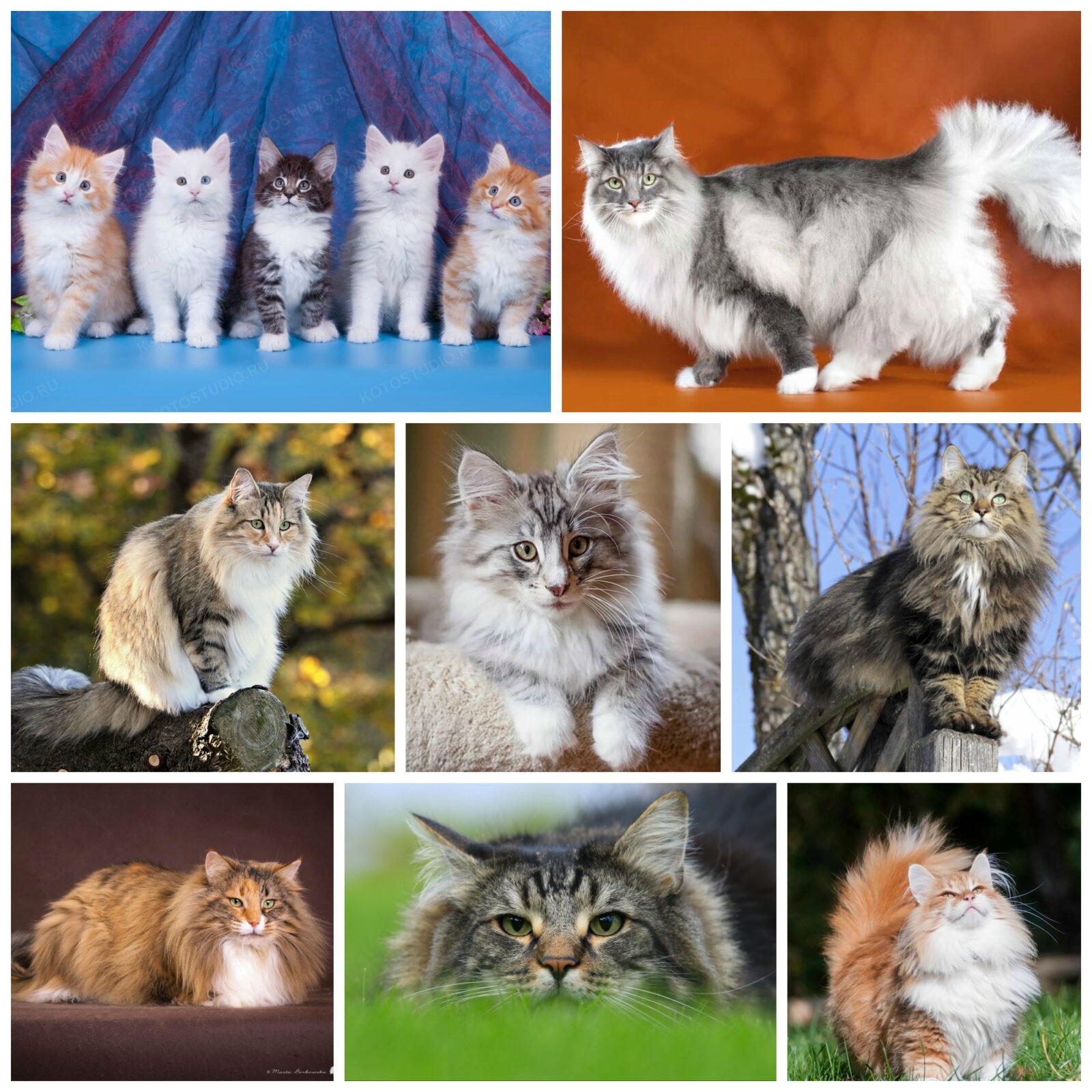
Brief description of the breed
Long, thick hair is the main asset of the Norwegian Forest cats. The head has a characteristic triangular shape, pointed at the chin. The head is decorated with ears of medium length with a characteristic crest.
Large almond-shaped eyes can have a different color: green, gold, copper, while white cats can have eyes of blue or different colors (one is blue, and the other is green, gold or copper).
A moderately elongated body gives the animal the appearance of a strong pet, muscular hips and chest complement this picture. Large round paws have tufts of wool between the fingers. The tail of the Norwegian Forest is the same length as the body, and, of course, it is very fluffy.
The water-repellent undercoat of cats of this breed has different lengths on different parts of the body. It is noteworthy that in the summer, the hair on the pet becomes noticeably less. As for the color, it can be almost anything with or without patterns.
friendly norwegian forest cat - a great choice for any family with small children. The animal loves the attention of children to itself, treats them gently, is not averse to playing and frolic.
Representatives of this breed get along well with other cats, and dogs. True, in this case, from the first day the pet appears in the house, it is necessary to carry out the process of socialization.
https://moyhoroshiy.ru/porody-i-otzyvy/koshka-bogini-freii
basic information
| Breed name: | Norwegian Forest Cat |
| Country of origin: | Norway |
| The time of the birth of the breed: | many centuries / millennia ago |
| The weight: | 6 – 11 kg |
|
EMS code:
|
NFO |
| Life Expectancy: | 12 - 15 years old |
| Kitten price: | 150 – 1700 $ |
| Most popular nicknames: | List of nicknames for Norwegian Forest Cats |
Assessment of breed characteristics
|
Adaptability
(A definition that means how easily a cat can adapt to changes in life)
|
🐱🐱🐱🐱🐱 |
|
Shedding level
(Level and frequency of hair loss in the animal)
|
🐱🐱🐱 |
|
Tenderness level
(The level and amount of tenderness and affection that the cat gives in return for attention to itself)
|
🐱🐱🐱🐱🐱 |
|
Social need
(The required number of contacts of a cat with other animals, as well as people)
|
🐱🐱🐱🐱🐱 |
|
Grooming
(The number of bathing, brushing, and the number of professional grooming sessions required for the cat)
|
🐱🐱 |
|
Friendliness in an unfamiliar environment
(Features of the cat's behavior in a society with strangers or in an unfamiliar environment)
|
🐱🐱🐱🐱🐱 |
|
Health issues
(Potential health status of a cat)
|
🐱🐱🐱 |
|
Intelligence
(The ability of a cat to think and solve emerging difficulties)
|
🐱🐱🐱🐱🐱 |
|
Friendliness to children
(A factor that determines how friendly a cat is to children, whether she likes to play with them and tolerate some childish pranks)
|
🐱🐱🐱🐱 |
|
Game activity
(The concept is determined by its very name, and, as a rule, is found in almost all cats)
|
🐱🐱🐱 |
|
Dog friendly
(The cat's tendency to get along with dog)
|
🐱🐱🐱🐱🐱 |
Photo of the Norwegian Forest Cat:

History of the Norwegian Forest Cat
The homeland of the Norwegian Forest Cat, as the name suggests, is Norway. Its history is deeply rooted in centuries, and perhaps even millennia. Many fairy tales and legends are associated with this cat in Norway. According to one of them, the Scandinavian goddess Freya rode a chariot drawn by six cats of this breed.
Where and how the Norwegian Forest Cat originated remains a mystery. It is believed that cats of this breed may be descendants of long-haired cats from Turkey, which were brought to Scandinavia from Byzantium. It is also possible that the origin of the Norwegian Forest Cat is related to Siberian cats From Russia. These pets could have been brought by the Vikings, or their appearance is due to ordinary natural selection: short-haired cats may have developed long hair with a water-repellent undercoat due to exposure to the difficult arctic climate.
In Norway, this cat has always been called "skogcatt", which literally means "forest cat". These intelligent cats became the ultimate rat-catchers for the Norwegians and were very popular on farms, barns and stables.
In 1938, cats of this breed were presented at an exhibition in Oslo. The Second World War made a negative contribution to the development of the breed, but fortunately they managed to survive the difficult war period. But even after the end of the World War, the selection of Norwegian Forest cats was very sluggish until the seventies of the last century.
In 1977, the International Cat Federation officially registered the breed. Two years after this event, several animals of this breed were transported to the American continent. The breed began to gain its popularity, both in the United States and in Europe.
Character of the Norwegian Forest Cat
The Norwegian Forest Cat is distinguished by its tenderness and friendliness. It requires constant attention and affection from the owners. Despite the fact that representatives of this breed really appreciate the company of a person, they can still have a good time without anyone's presence. Even when everyone is at home, these pets may not show much of their desire to be the center of attention. The only thing that a Norwegian cat will never refuse is to be treated kindly by its owner.
These pets are characterized by classic Scandinavian restraint. They emit their quiet voice only when they really need something, or when they seek to draw attention to themselves.
It is not surprising that such a large and strong cat climbs well. It can often be seen at the highest point of the house. The animal is distinguished by fearlessness and self-confidence.
As already mentioned, cats of this breed have a waterproof undercoat. This feature suggests that Norwegian cats are not afraid of water, and therefore have a certain fishing instinct. If you have an aquarium in the house, make sure that it is securely closed, otherwise its inhabitants may become the prey of your new four-legged friend.
The Norwegian Forest cat is extremely smart, she learns everything very quickly, loves to play and develops well surrounded by an active and loving family.
Maintenance and care
The Norwegian Forest Cat is the owner of a long coat with a thick undercoat. Therefore, at least twice a week, it is necessary to comb out the coat with a special brush or stainless steel comb. If tangles have formed on the wool, they must be carefully removed.
Cats of this breed practically do not need bathing. The thing is that the undercoat is almost completely waterproof, so there is no point in baths, in principle.
Periodontal disease and other dental diseases can be avoided by weekly oral hygiene, so make sure to brush your pet's teeth every week. You can feed them like other purebred cats.
Eyes also require attention, the corners of which must be wiped once a week with a cloth (separately for each eye). Weekly procedures include monitoring the condition of the ears. It is necessary to ensure that they do not cause irritation, infection, inflammation. Ears are treated, as a rule, with a special solution prescribed by a veterinarian or a mixture of vinegar and water in a one to one ratio.
Perfect purity cat tray not only prevent the occurrence of an unpleasant odor in the house, but also prevent the occurrence of various infectious diseases, and also keep the animal's coat clean. Give your Norwegian Forest Cat lots of space and be sure to scratching post.
The Norwegian Forest Cat is, of course, an animal that is predisposed to living in cold climates. But this does not mean at all that a pet should live on the street. In this case, your pet may be attacked by dogs or other cats. And do not forget that the pet needs communication, affection and attention, which you cannot give if the cat lives on the street.
It is also important to properly feed the Norwegian cat in order to maintain its beautiful coat and good health. Considering the acquisition dry and wet food, then first you should carefully study the composition of the product, read customer reviews.
Health and disease
Most pedigreed cats have genetic problems. Fortunately, this fate has bypassed the Norwegian Forest cat, which, in principle, is considered a relatively healthy pet. Consider several diseases that are characteristic of this breed.
Glycogenosis is a fairly rare hereditary disease that has a negative effect on glucose metabolism in the cat's body. Most kittens with this condition are stillborn or die within hours of birth. True, sometimes the disease may not manifest itself at all for up to six months. Survivors kittens with this disease most often die a few months after birth. With the help of a special genetic analysis, it is possible to determine whether a cat is a carrier of this disease.
Polycystic kidney disease is one of the few genetic diseases that is common in Norwegian Forest cats. This disease has a devastating effect on the kidneys. The disease can be diagnosed using ultrasound.
Hypertrophic cardiomyopathy is a form of heart disease that is also inherited. Another disease that pets of this breed can suffer from is retinal dysplasia. This disease involves the appearance of spots on the retina of the eyes, which subsequently leads to a decrease in vision or blindness. See also: the most common eye diseases in cats.
Some interesting facts
- The history of Norwegian cats is not fully understood, therefore it is full of secrets and legends.
- The Norwegian Forest Cat is the best choice for families with small children.
- Caring for pets of this breed is not so difficult, but it takes time and attention.
- The Norwegian Forest Cat is very similar to Maine Coons.
- The Norwegian Forest cat is considered to be a relatively healthy and hardy cat.
Nurseries and breeders
We borrowed material from the wonderful site of our partners DOGCATFAN.COM about cats and dogs, the author dogcatfan
